Gigabyte GA-X79-UD3 Review
by Ian Cutress on December 26, 2011 4:37 PM EST- Posted in
- Motherboards
- Gigabyte
- X79
- Sandy Bridge E
Unfortunately with our gaming benchmarks, I came up against a small issue with the board. The first PCIe which is rated at x16 would not run in x16 mode, only giving me x8 bandwidth. After confirming with Gigabyte, this seems to be more a manufacturing anomaly than anything else. I was able to use the second x16 slot for single-GPU testing at x16, however dual-GPU testing was limited to x16/x8. Overall, this only really showed in Dirt3, as shown below.
Aliens vs. Predator Benchmark
Aliens vs. Predator is a DirectX 11 science fiction first-person shooter video game, developed by Rebellion Developments. Available as a standalone benchmark, on default settings the benchmark uses 1920x1080 with high AF settings. Results are reported as the average frame rate across 4 runs.
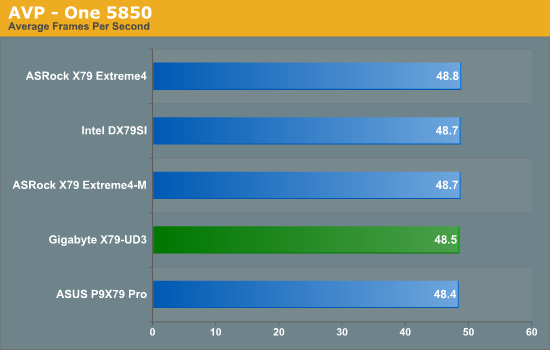
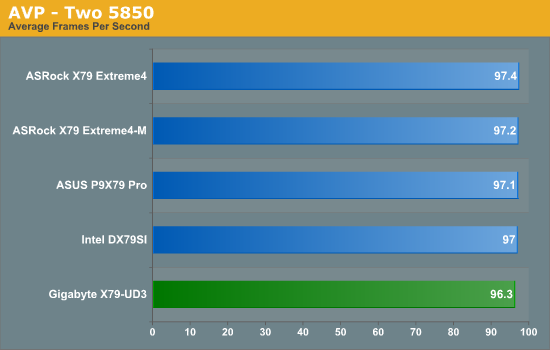
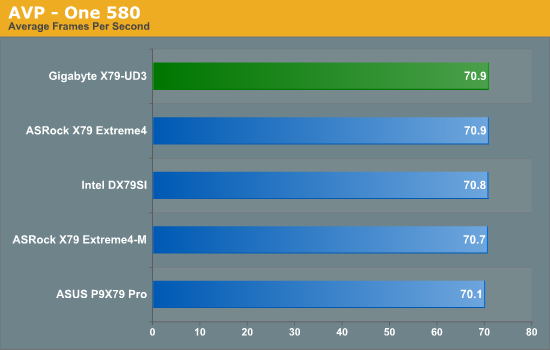
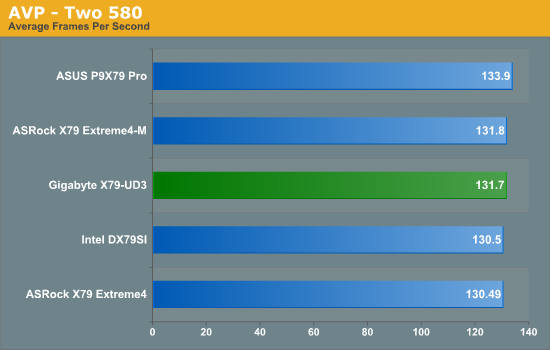
Dirt 3
Dirt 3 is a rallying video game and the third in the Dirt series of the Colin McRae Rally series, developed and published by Codemasters. Using the in game benchmark, Dirt 3 is run at 1920x1080 with full graphical settings. Results are reported as the average frame rate across 4 runs.
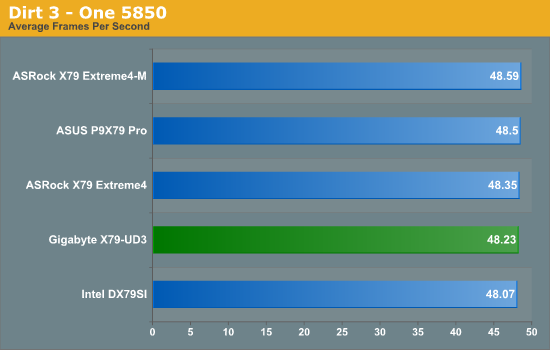
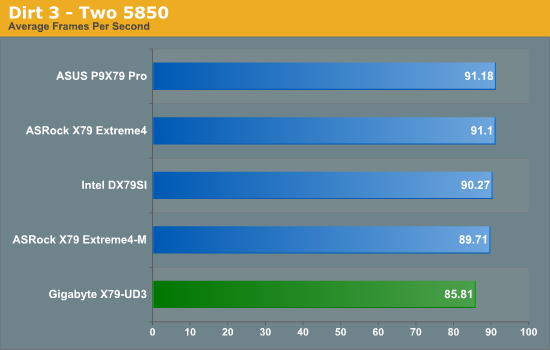

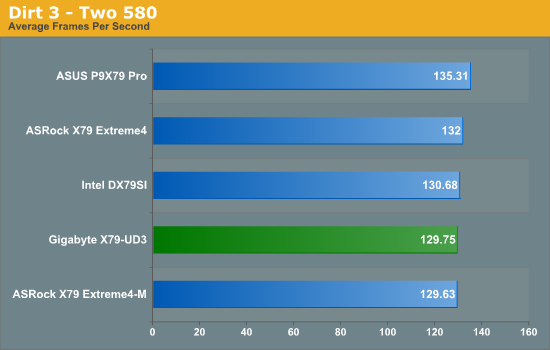
Metro2033
Metro 2033 is a challenging DX11 benchmark that challenges every system that tries to run it at any high-end settings. Developed by 4A Games and released in March 2010, we use the inbuilt DirectX 11 Frontline benchmark to test the hardware at 1920x1080 with full graphical settings. Results are given as the average frame rate from 10 runs.
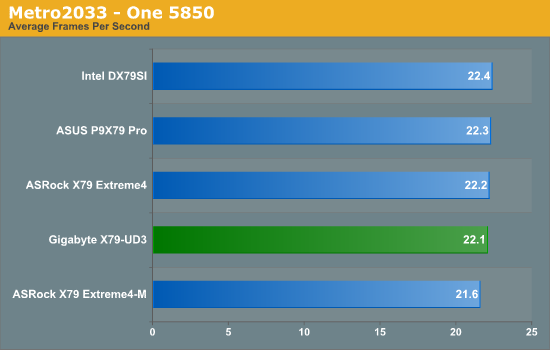
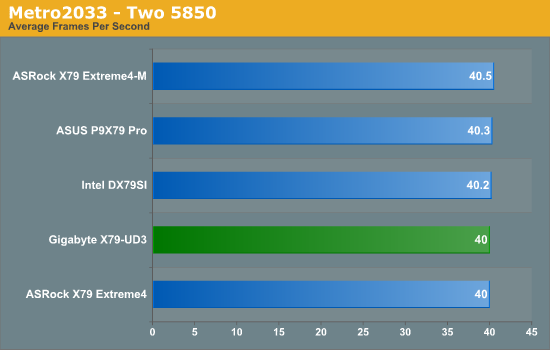
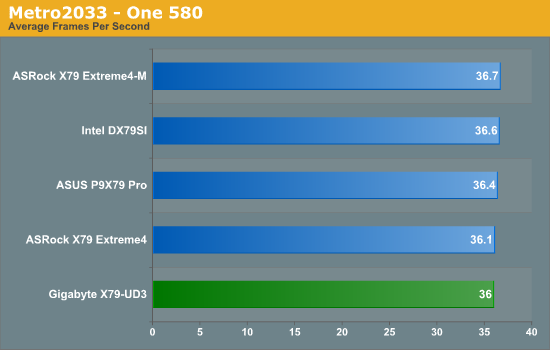
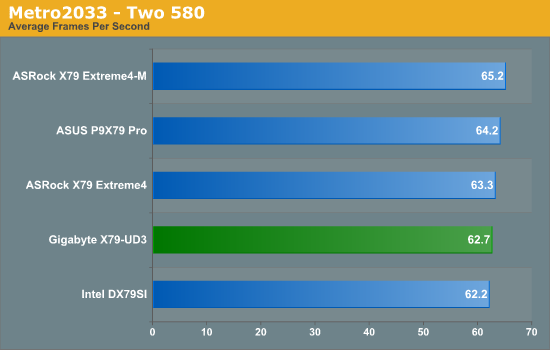
Conclusions
There's nothing much special about the GPU performance, as to be expected.










39 Comments
View All Comments
sor - Wednesday, December 28, 2011 - link
I've had three different motherboards with realtek 8111 nics on them, all of them regularly had issues where the link would go to 100mbit or drop out altogether, which required disabling the device and then reenabling it/reinstalling the driver... almost daily. Granted, this was with Linux and the driver might not be up to par (though I used the one from Realtek's website after having issues, with no improvement), but since it's what I use at home and at work I much prefer the reliability of the Intel NIC and drivers.ET6 - Saturday, December 31, 2011 - link
You do need to have more than one Ethernet NIC on the physical computer if you are going to install Virtual Machines. For example, you could install Windows Server 2008 R2 with Hyper-V first. You could then install several VMs; one running Windows 7 with Media Center for media transcoding and content display; one running Windows Home Server 2011 as a media server etc; and maybe a third running Windows SQL Server 2008 or Visual Studio Team Foundation Server 2010.You need a dedicated NIC for all network communications with the management operating system incuding remote access to the Hyper-V role. The management operating system runs the Hyper-V role. This NIC should be different than any mapped to VMs.
Need at least one other Ethernet NIC to provide Virtual Machine access to an external virtual network.
Now you might have reason for 32 or 64 Gig of RAM.
zanon - Monday, December 26, 2011 - link
I had thought that at this point most manufacturers would finally be moving to EFI, and that that was an important part of enabling some of these more modern GUI configs. However, you don't mention EFI at all, so does that mean these are still using legacy BIOS, just further hacked on? Or are you using "BIOS" in some generic sense? If it's the former then that's both too bad and somewhat interesting, wonder what the hold up is. If it's the latter it's confusing, please stop immediately and don't do it again.tpi2009 - Monday, December 26, 2011 - link
If you read the screenshots in the second page of this review you'll find your answer.zanon - Tuesday, December 27, 2011 - link
The screenshots say alternatively "3D BIOS", "Dual UEFI BIOS", "BIOS Features" and "UEFI DualBIOS" with the article itself never referring to EFI at all. Awesome clarity and consistency there! Does "Dual" mean that it has both EFI and BIOS? Are the selectable, or is there some sort of automatic switching, or what? Or is it just stupid confusing naming?Death666Angel - Tuesday, December 27, 2011 - link
BIOS is used as a synonym for UEFI afaict. "Dual" refers to Gigabytes use of 2 BIOS chips, meaning you cannot brick it with a BIOS flash gone wrong (though I haven't seen one of those in years).AstroGuardian - Monday, December 26, 2011 - link
I can't notice any performance difference from the graphs. How can you notice and how can you make such a poor verdict?RamarC - Monday, December 26, 2011 - link
it wasn't a low rating... just a bit middle of the road because of the XMP issues and the price."In terms of performance, we are not seeing anything stellar with the GA-X79-UD3." so it doesn't hit the best-of-the-high-end marks but it's still a good mobo.
"If it were my money on the line, it would be a hard choice between the UD3 and the ASRock X79 Extreme4." that sounds like a mid-range endorsement to me.
So overall it seems to be a solid 'B'... you just need to see if 'pretty good' is worth your money.
PS to AT: thanks for the recent hardware reviews -- since I was getting very tired of smartphone writeups since a) I (like a lot of folks) am tied to a carrier and thus limited to their offerings, and b) I read AT for PC tech (not phone tech, and I can upgrade PC tech at my choosing.)
gevorg - Monday, December 26, 2011 - link
Does Gigabyte continues to ignore the fact that their BIOS lacks basic case fan controls? Unacceptable for a $100+ mobo, let alone $250.Rick83 - Monday, December 26, 2011 - link
If it where only the BIOS - It's in fact the hardware chip that's only got two PWM-able outputs...